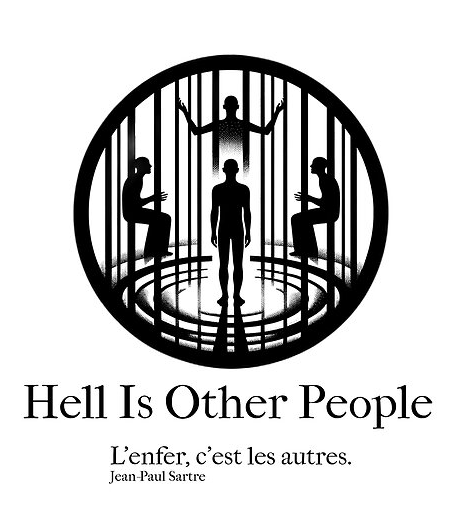Last Updated on April 4, 2025 by Iain S
Ah, Jean-Paul Sartre’s infamous line, “Hell is other people” (L’enfer c’est les autres) from his play “No Exit” (Huis clos)!
It’s a phrase that’s tickled the fancy of introverts and philosophers alike. And guess what? It’s also the perfect cheeky catchphrase for a design over at GloxxiDesign’s Redbubble shop.
Let’s set the scene: You’re at your favorite café, sipping on a cappuccino, lost in the world of your latest book.
But then, a wild group of chattering people appears, shattering your peaceful bubble. Wouldn’t it be just perfect to flash them a tote bag with “Hell Is Other People” boldly emblazoned on it? A polite, yet powerful statement that says, “Hey, I’m enjoying my solitude here.”
Now, imagine this phrase, “L’enfer, c’est les autres,” – something that screams sophistication with a hint of sass.
It’s not just a design; it’s a conversation starter, a statement piece, something that gets people thinking (and maybe even smirking).
Why not wear this iconic phrase on a T-shirt? Picture this: a sleek tee with the quote in a striking white font.
When you’re feeling a bit existential or when you just want to give the world a subtle nudge to give you some space. It’s casual enough for a day out but carries enough of a message to make a statement.
And for those who like to keep their philosophy a bit more low-key, how about a sleek poster?
Every time you pull out your phone, you’d be making a bold statement about the human condition – and let’s be honest, in today’s world, our phones are practically a part of our existential being.
The beauty of this design lies in its versatility. It’s not just for the philosophers or the introverts; it’s for anyone who appreciates a bit of wit and wisdom in their daily lives.
And let’s not forget, it’s a fantastic way to pay homage to one of the greatest existentialist thinkers of all time.
So, if you’re looking to add a touch of existential flair to your wardrobe or everyday items, head over to GloxxiDesign on Tostadora.
Whether you’re a Sartre enthusiast, an introvert, or just someone who appreciates a good quote, there’s something there that’s bound to resonate with you. And who knows? This might just become your go-to piece for those days when the world feels a bit too crowded.
Check it out and embrace your inner philosopher with style!
Let’s dive into the existential world of Jean-Paul Sartre and his play “No Exit” (“Huis Clos” in French).
Jean-Paul Sartre: A Brief Overview
- Birth: Born in 1905 in Paris, France.
- Philosophy: Sartre was a leading figure in 20th-century French philosophy, particularly existentialism and phenomenology.
- Existentialism: He is best known for his existentialist works. Existentialism is a philosophy that emphasizes individual existence, freedom, and choice. It is the view that humans define their own meaning in life, and try to make rational decisions despite existing in an irrational universe.
- Literary Works: Sartre was also an accomplished playwright, novelist, and biographer.
- Politics and Beliefs: He was noted for his relationship with the prominent feminist theorist Simone de Beauvoir and his involvement in leftist politics.
- Nobel Prize: Interestingly, he was awarded the Nobel Prize in Literature in 1964 but declined it, stating that he consistently refused official honors.
- Death: Sartre passed away in 1980, leaving behind a rich legacy of philosophical and literary work.
“No Exit” (“Huis Clos”): A Snapshot
- Publication and First Performance: “No Exit” was first performed in 1944 during the German occupation of Paris. The play is a one-act existentialist drama.
- Setting: The story is set in a room that is meant to be hell, where three characters are brought after their deaths.
- Characters: The main characters are Garcin, Inès, and Estelle. Each character represents different aspects of human behavior and their interactions explore Sartre’s existentialist ideas.
- Garcin: His character is portrayed as being attracted to women. He has a history with women in his past life, most notably his treatment of his wife. In the play, he develops a complex relationship with Estelle.
- Inès: She is depicted as a lesbian in the play. Her backstory includes her attraction to another woman, Florence, which plays a significant role in her character’s history and the unfolding drama in the room.
- Estelle: She is shown to be heterosexual. Her past life includes relationships with men, and in the play, she expresses a desire for Garcin’s attention and affections.
- Themes: The play delves into themes of existentialism, freedom, and responsibility. It challenges the characters (and the audience) to confront their past actions and their consequences.
The Impact of Sartre and “No Exit”
- Philosophical Influence: Sartre’s ideas have significantly influenced existentialist thought. His notion that “existence precedes essence” suggests that people first exist and then define themselves through their actions and choices.
- Literary Significance: “No Exit” is a cornerstone of existential literature, offering a compelling portrayal of the human condition and the complexities of interpersonal relationships.
- Cultural Legacy: Sartre’s philosophical concepts, especially those presented in “No Exit,” continue to resonate in modern culture, influencing everything from literature and psychology to pop culture and everyday conversation.
Sartre’s work, including “No Exit,” challenges us to think about our existence, our freedom, and how we interact with others, making him a pivotal figure in both philosophical and literary circles.
His exploration of these themes in “No Exit” provides a fascinating, albeit somewhat bleak, view of human nature and relationships.


